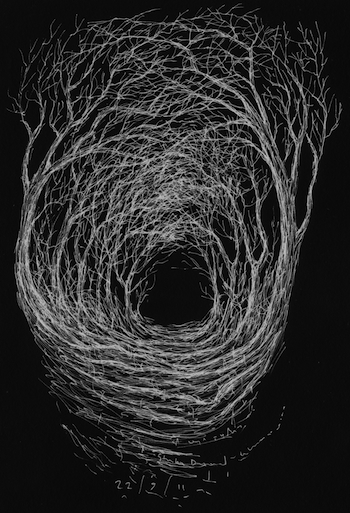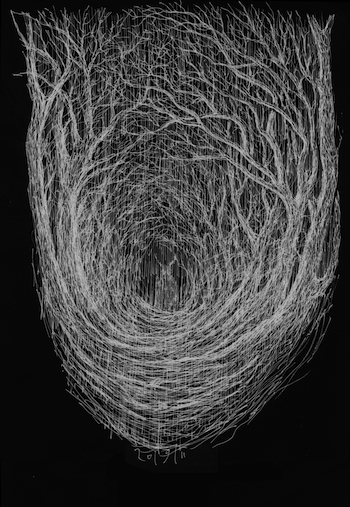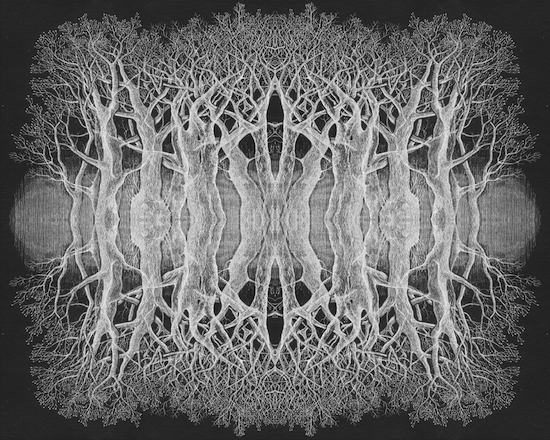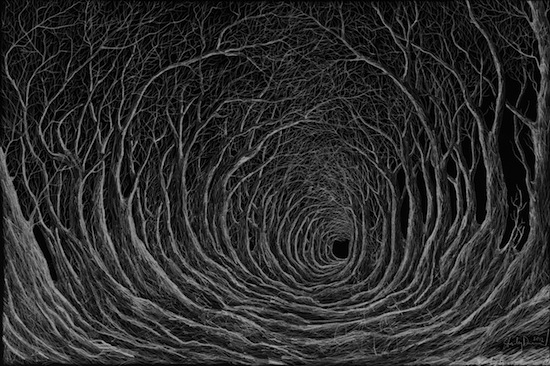‘Like creases in the hand, or the wear on the stone sill of a doorstep or stair, they are the result of repeated human actions. Their age chastens without crushing. They relate to other old paths & tracks in the landscape — ways that still connect place to place & person to person.’
Robert Macfarlane — Holloway
I first met Robert Macfarlane in Cambridge, December 2009.
Snow spun about us and crunched underfoot as we crossed the Emmanuel College quad. A sparrowhawk flew over with its dark dove silhouette. The lido was frozen over — thick enough to support a morose duck — and the famous oriental plane tree stood out black bronze in the stalling light.
Robert had agreed to see me as part of a hilariously uncommercial book I was writing called The Beechwood Airship Interviews and, in keeping with its aberrant nature, when we got to his rooms I found my tape recorder had broken. [1]
The notes I later scribbled record that we spoke about Robert’s books and writing, looked at a book of fires, pyres and stoves by David Nash — a gift from Roger Deakin — and discovered a shared interest in the artificers and trench diggers from The Great War, polar sastrugi, the painter Paul Nash and the band Pixies.
As I was leaving, I paused — recalling another, earlier, conversation had in Bath — and said, ‘You know the sunken road in Dorset which you explored with Roger? I spoke to Stanley Donwood a while back and he’s haunted by it. I think he’d like to seek it out. I think he’d like to make a book.’
And then I ran into the snow for my inevitably cancelled train.
Dorset, 2011
The late September light is flat and warm. We are in Dorset — Robert, Stanley Donwood and I — sitting on a grass slope which runs down to a hedgerow beyond which a small farm can be seen and a dog heard to bark — the blunt sound carrying on the still air. We’ve set up house in a hollowed hedge away from prying eyes and now laze above that dry chute having hidden our rucksacks, bivvy bags and bikes down in its leafy privacy, pondering the best way to the pub — the latest travellers on a well trod path.
Holloways run through landscapes founded by soft stone, worn down over centuries by long gone hooves and feet. Many have become roads — routed out by traffic, their weathered sides lost in a high speed tarmac rebore — but many more have endured, forgotten. Ancient foot-querned oxbow lanes. Quiescent low-ways taken back and occupied by wild nature, dappled aisles spanned by vaulting trees which crane and fuse to form green tunnels and camouflage these old routes, ‘the wood that overhangs and underyawns it’ as the poet Edward Thomas wrote:
‘…the path that looks
As if it led on to some legendary
Or fancied place where men have wished to go
And stay; till, sudden, it ends where the wood ends.’ [2]
I first read about this place in Robert Macfarlane’s book The Wild Places which details a journey he made here with Roger Deakin in July 2004. They drove down in Roger’s car which had moss in the footwells; they lit fires and hid out; climbed trees and swam naked in the sea, absorbed in serious fun — an adventure for grown-up boys raised on the derring-do of Buchan and practical wisdom of Baden-Powell — wielding trusty penknives to open tins of provisions, bloodying their hands and maps on blackthorn, sleeping out under the stars [3] … specifically in this place, this deep, forgotten sunken road, because of the pivotal role it played in the novel Rogue Male, published by Geoffrey Household in 1939.
I say, ‘this place’ but ‘general area’ or ‘sense of place’ might be nearer the mark since the locations described in Household’s book appear to have been composite spaces, sewn together from the author’s intimate knowledge and experience of the landscape and deployed to best serve his narrative:
‘The outer or northern slopes look down upon the Marshwood Vale. Here I passed out of chalk and into sandstone; the lanes worn down by the packhorses of a hundred generations plodding up from the sea on to the dry, hard going of the ridges, were fifteen feet below the level of the fields. These trade-worn cantons of red and green upon the flanks of the hills are very dear to me.’[4]

Roger and Robert searched the labyrinth of hollow ways around the Chideock valley for a point where Household’s patchwork clues converged — orienteering by the book — trying to align the sandstone of an embankment, the view down the valley, a steep hillside behind a lost road diving down into fifty feet of darkness, sentinel barbs, a tree-formed tunnel… but nowhere quite tallied with the spot where Household’s hero hid; the crease lines of the valley were too numerous and knotty to be understood in a long weekend, a week, a month… and the secret remained.
And now Robert is back, with Stanley and I in tow — that comment in the Cambridge quad having bloomed into a collaboration, a journey and an exploration of the dormant fosse paths within these crescent hills with a view to documenting this vortex space in a book of words and cross-hatched illustration:
‘A slender volume with marbled endpapers, embossed details… loose leaves of additional notes, impressions engendered by the place — fragments of ideas.’ [5]
And so we bedded down that first night in Dorset, Robert in the sleeping bag which has warmed him atop mountains and in the midst of wilderness, Stanley in a bijou one-man tent and I in Roger Deakin’s hooped bivvy bag.
Robert read to us from a book of Edward Thomas’ poems that he’d brought and then I burrowed my way to sleep, thinking of this confluence of work and people; how bonkers that a beechwood airship should spin me down into this bush of ghosts.
The holloway is a space steeped in absence. It reminds me of the overgrown canal network which can still be traced in the countryside around Bath. Built to carry coal away from the mines around Radstock, the waterways were superseded by the railways — often laid on top of their drained courses — before they too were purged and faded from the map.
Cows now graze turf covering aqueducts; banked-up tunnels pass unseen under roads; forgotten abutments edge meadows, witness to an in-filled past, their stones scarred by the ropes from the horses which pulled the laden barges. Upended sleepers have become gate posts and barn stockades, deep oolite basins yawn ivy beside towpath cycle ways.
Such industrial archeology tracks back to our Dorset bostle where feet and hooves and carts eroded a relation of the rock corridors near Camerton, the ruined flights of locks around Combe Hay and the echoing viaducts of Midford where two railway lines once crossed on limestone arches. [6]
This latent narrative and energy within landscape seems to be a vital driving force within both Robert and Stanley’s work; the tension between elemental geology and the ambitions of man; the way we inhabit, plot and change the terrain — concerned with our place in the broader scheme and the traces left behind. In books about mountains, wild places and old pathways, Robert travels to the heart of worlds obscured, forgotten or apparently superseded to report and respond, and more often than not he brings news of sites which have lapsed rather than died, altered but enduring unseen — Land Writing, kindred of Land Art and similarly rooted in the ground; a response to the earth and its territorial imperatives — whilst Stanley, well, oneiric doom and apocalypse are omnipresent themes in his artwork, the Vorticist inferno flood encasing Atoms For Peace’s AMOK a vivid case in point.
The original printing of Holloway was undertaken in Oxford in the Spring of 2012 by Richard Lawrence ― a letterpress printer for thirty years standing.
At some point the decision was taken to use a monotype caster to cast fresh type from molten lead and employ the font Plantin — first cut in 1913 for the Monotype Corporation, based on a face cut in the 16th century by Robert Granjon.

The type was made by using a large keyboard to punch holes in a paper tape about five inches high ― tape akin to that of a player-piano. The text was input ‘blind’; that is, the person doing it has only their memory to tell where they were in the text and whether or not they’d made any mistakes. All they had to show for hours of punching keys was a roll of white paper, pocked with small rectangular holes.
The roll of paper in no way resembled a book, nor text, nor a typeface, nor, in fact, anything much at all. But it’s where the book began, as it contained all the information needed to cast the type, which was done on the adjacent monotype caster — which spat, ricocheted and hammered away madly in contrast to the reassuring ‘Pish ti’coo; Pish ti’coo’ of Richard’s Heidelberg presses, on which the finished type and Stanley’s layered, hypnotic drawings — now photo-etched to zinc plates — were printed; 277 copies: the height of Pilsdon Pen above sea level — the misted hill fort where we began our Dorset jaunt.
‘Waking in the holloway the thing that struck me, lying half out of my green cocoon and staring up — staring through the awning mesh of twigs and stems — was the way their patterns shone white when I blinked or turned away. A fretted photo-negative weaving with the vessels in my eye.
Burnt in. Of a piece.
Once up, we sat round in the bank, ears pricked. We slept well but for the rain at four, faintly aware of the bird song swell with the sun — the hedges here are stuffed with birds; abundant, loud and brazen-bright as we are out of place. We hide ourselves as émigrés, as artificers in a trench, sat with our sub rosa gin below the parapet.
Some 250 miles east, in an archive box, I found a card:
As an only child, the sheer solitude of the hero’s escape and odyssey appealed to me. He was a swimmer too, dragged his tortured body into the Rhine like an otter — throwing off the guard-dogs that pursued him.’ [7]
But let’s be clear, our time in the hedge was more Three Men In A Boat than The 39 Steps — for all the doom intimated by our initial walk atop Pilsdon Pen with its glum cows and misted ramparts. No, for all the Rogue Male grounding, the endeavor felt much more akin to a daft farce — bicycles collapsing left, right and centre, we three hiding in our hole for fear of being discovered by irate dog walkers, drinking gin and eating cake like naughty schoolboys, falling over roots in the middle of the night; Boy’s Own stuff but far from Household barbarism. It was not: ‘By that time I had, of course, been knocked about very considerably. My nails are growing back but my left eye is still pretty useless;’ nor was it: ‘I didn’t feel the pain any longer. I could persuade myself that I was no more seriously hurt than when they put me over the cliff; so I determined to move off before they came to find my body‘ [8] — it was much more: ‘At this moment, the laurel bush, which had hitherto not spoken, said ‘Psst!’’ [9]
Back in Robert’s Emmanuel rooms, almost four years to the day of our first meeting, the sash windows again overlooking a tundric Parker’s Piece, the snow drawing the eye and what little warmth there is outside.
The 277 copies of Holloway that we made have been sold and there’s talk of a general edition to come in the spring — we seem to have formed an accidental team: Quive-Smith Press — Macfarlane, Donwood, Lawrence & Richards.
Robert looks out to the white common square, reflecting on the odd journey we’ve made.
‘Getting lost is a very fine experience, you know. I like whiteouts and mist for that reason, but Edward Thomas was brilliant at looking at an Ordinance Survey map and following the old route where it was broken into fragments but still existed as place names, footpaths — he could almost see it in its shattered form — but I don’t possess that capacity… but I’m fascinated by people who know places very very well — the ways paths run through people as well as they run through places… connecting places to places and people to people, relating as much in the sense of joining and they relate in the sense of telling.’
And then we shake hands and go our separate ways; Robert home to his new son, Will, and the massing tomes of the Booker Prize and me to the station in the snow for my inevitably cancelled train.

Holloway is published by Faber & Faber on May 16th
On May 14th Caught By The River and Faber & Faber present the launch of Holloway at Rough Trade East, Brick Lane, London. The event features guest speakers… Dan Richards, Malcolm Anderson and Andrew Weatherall — Plus letterpress printing by Stanley Donwood and Richard Lawrence and a bespoke musical selection by Stephen Cracknell (The Memory Band)
[1] ‘The most inept interview I’ve ever been involved with.’ — Robert Macfarlane
[2] The Path — Edward Thomas, 26th March 1915
[3] ‘The various subtle shifts of position to get comfortable whilst sleeping out on wild land / long grass. To change my head from elbow to forearm or to twist my feet from resting on the ankles to resting on the insteps’
[4] Geoffrey Household, Rogue Male — It’s hard to read these words and not imagine the book’s author and unnamed hero to be one and the same
[5] A note from Stanley, written around the time of our visit
[6] The opening shots of the 1953 Ealing Comedy The Titfield Thunderbolt were filmed at Midford and show the tracks passing one above the other — the Somerset & Dorset Joint Railway over the Limpley Stoke to Camerton branch, redundant even then. Apparently the drivers on the S&D had great fun trying to disrupt filming with gratuitous whistling whenever they passed overhead. Scenes of a manic Sid James driving a traction engine assured the film cult status
[7] An extract from Holloway. The last paragraph quotes from a Deakin note unearthed at his UEA archive
[8] Rogue Male, Geoffrey Household, Chatto & Windus, 1939
[9] Summer Lightning, P.G. Wodehouse, Herbert Jenkins Ltd, 1929.


